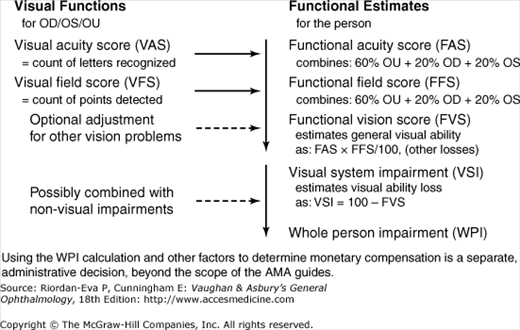History
Vision loss is a complex phenomenon that cannot be fully understood unless many different aspects are considered (see Chapter 25). Yet, for certain applications it may be desirable to reduce this complex reality to a single number. Administrators prefer the oversimplification of the single number approach when they have to decide on eligibility for benefits or for worker’s compensation cases, where the outcome also is a single number: the amount of compensation.
Formulas to calculate what was then called “Visual Economics” were first proposed in Germany in the late 1800s. In 1925 Snell proposed to the American Medical Association (AMA) a simpler formula for “Visual Efficiency.” This formula, reflecting an 80% loss of employability for a visual acuity loss to 20/200, served until 2000. In its fifth (2001) and sixth (2008) editions the AMA Guides to the Evaluation of Permanent Impairment adopted the “Functional Vision Score” (FVS), which reflects an estimate of the ability to perform Activities of Daily Living (ADL).
On the new scale, 20/200 acuity is rated as an estimated 50% loss of ADL ability, rather than as an 80% loss of employability. Other changes include no longer considering the two eyes as separate organs, vision with both eyes open being the normal condition. The new scale has been shown to correlate well with other measures of ability.1
Calculating the Functional Vision Score
Figure A–1 represents the steps in calculating the functional vision score and its use in calculating an AMA impairment rating.
Stay updated, free articles. Join our Telegram channel

Full access? Get Clinical Tree



